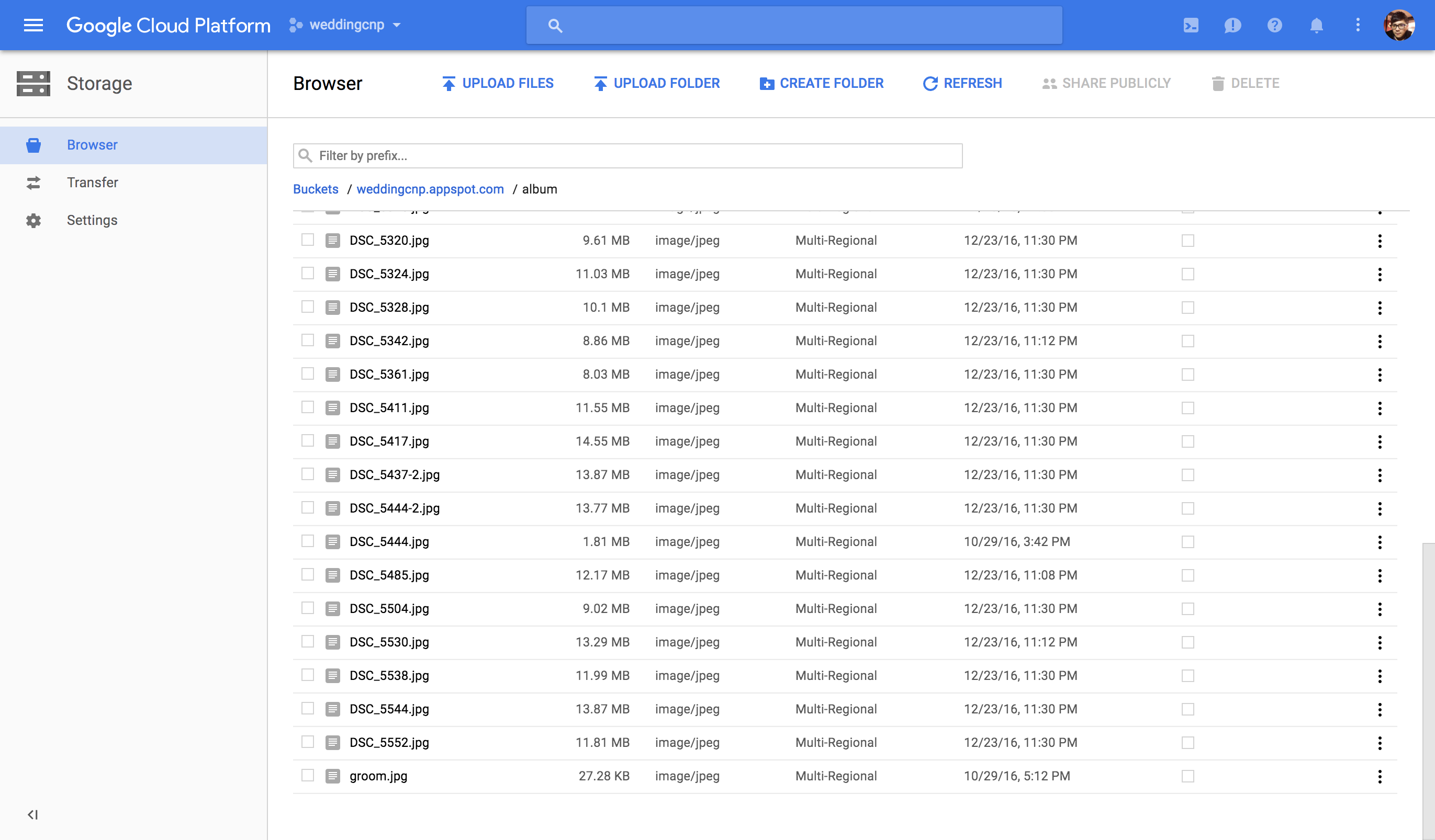此篇就對 Cage & Ping wedding frontend Service 使用了 GAE standard runtime 搭配 echo 網頁框架實作介紹
weddingcnp 系例傳送門
- weddingcnp via GCP 簡介
- weddingcnp via GCP - 1. 專案架構切分
- weddingcnp via GCP - 2. 前端頁面設計實作
- weddingcnp via GCP - 3. endpointAPI 設計實作
- weddingcnp 前端 vue.js 設計實作
- weddingcnp edm 寄送 sendgrid
weddingcnp 前端頁面設計實作
Cage & Ping wedding frontend Service(Module) 主要的功能如下
- serve 靜態資源(audio、js、images、css),serve 動態資源(婚紗照片由 Google Cloud Storage 提供)
- 服務整個主體的網站架構中模版

frontend Service
1
2
3
4
5
6
7
8
9
10
11
12
13
14
15
16
17
18
19
20
21
22
| .
├── public // static resource
│ ├── audio
│ ├── css
│ ├── images
│ └── js
├── templates // html templates
│ ├── bingo.tmpl // bingo game
│ ├── chiayi.tmpl // 地點引導
│ ├── gallery.tmpl // 婚紗相簿
│ ├── greeting.tmpl // 隱藏網頁,連結由喜帖中的 QR code 提供
│ ├── index.tmpl
│ ├── layout.tmpl
│ ├── live.tmpl
│ ├── luzhu.tmpl // 地點引導
│ └── rsvp.tmpl // 報名頁面
├── app-engine.go
├── app-standalone.go // Google App Engine entry point
├── app.go
├── app.yaml // frontend services yaml
├── index.yaml // index for Datastore
└── main.go // echo framework entry point
|
Google App Engine Basic
Google App Engine 現在有提供 Standard 及 Flexible 的版本
Standard:
- Python 2.7
- Java 7
- PHP 5.5
- Go 1.6
Flexible:
- Python 2.7/3.5
- Java 8
- Node.js
- Go 1.8
- Ruby
- PHP 5,6,7
- .Net
- Custom Runtimes
二者最大的差異是 Standard runtime 為 Google Fully management,所以享有每天 28 instance FREE 的配額,Flexible runtime 是以 GCE 的 instance 來跑,所以基本上的計價方式就是以 GCE 的計算方式,以分計費(最少收 10 分鐘的錢),且因為是 GCE 的方式來跑,因此彈性上就會比 Standard runtime 的來的大,不過缺點就是一開機器就開始算錢惹。在 weddingcnp 專案一開始就希望能夠少花一點錢,評估上 Standard runtime 就已經滿足需求
Cage & Ping wedding frontend Service(Module) 選擇使用了 Standard runtime 中 Go 語言的實作方式。由於前端需求並不複雜且 Go 實作的方式要比 Python 來的簡潔,部署至 Google App Engine 上的專案大小、記憶體的表現都上 Go 的表現要來的比 Python 來的要好,因此選擇了 Go 來實作。
各位朋友就端看自己的需求來評估要使用那一種 runtime
Google App Engine: hello example
app.yaml
1
2
3
4
5
6
| runtime: go
api_version: go1
handlers:
- url: /.*
script: _go_app
|
hello.go
1
2
3
4
5
6
7
8
9
10
11
12
13
14
| package hello
import (
"fmt"
"net/http"
)
func init() {
http.HandleFunc("/", handler)
}
func handler(w http.ResponseWriter, r *http.Request) {
fmt.Fprint(w, "Hello, world!")
}
|
1
2
3
4
5
6
7
8
9
10
| # start GAE server
$ dev_appserver.py app.yaml
INFO 2017-06-18 04:02:36,963 devappserver2.py:692] Skipping SDK update check.
INFO 2017-06-18 04:02:37,519 api_server.py:272] Starting API server at: http://localhost:54584
INFO 2017-06-18 04:02:37,522 dispatcher.py:205] Starting module "default" running at: http://localhost:8080
INFO 2017-06-18 04:02:37,524 admin_server.py:116] Starting admin server at: http://localhost:8000
# fetch
$ curl http://localhost:8080
Hello, world!
|
Weddingcnp frontend
Go 由語言中原生就有提供 net/http 的 package 可以使用,所以可以很輕易的建立一個 Google App Engine Go Standard 的應用程式,不過 Google App Engine 還是可以搭配使用其他的網頁框架: gin-gonic/gin、echo 等,weddingcnp 使用了 echo 這一套輕量的網頁框架
Google App Engine Standard 是由 Google fully management,因此在使用 echo 框架需要特別的的調整一下
app-engin.go
1
2
3
4
5
6
7
8
9
10
11
12
13
14
15
16
17
18
19
20
21
| // +build appengine
package main
import (
"github.com/labstack/echo"
"github.com/labstack/echo/engine/standard"
"net/http"
)
func createMux() *echo.Echo {
e := echo.New()
// note: we don't need to provide the middleware or static handlers, that's taken care of by the platform
// app engine has it's own "main" wrapper - we just need to hook echo into the default handler
s := standard.New("")
s.SetHandler(e)
http.Handle("/", s)
return e
}
|
app-standalone.go
1
2
3
4
5
6
7
8
9
10
11
12
13
14
15
16
17
18
19
20
21
22
23
24
25
| // +build !appengine,!appenginevm
package main
import (
"github.com/labstack/echo"
"github.com/labstack/echo/engine/standard"
"github.com/labstack/echo/middleware"
)
func createMux() *echo.Echo {
e := echo.New()
e.Use(middleware.Recover())
e.Use(middleware.Logger())
e.Use(middleware.Gzip())
e.Use(middleware.Static("public"))
return e
}
func main() {
e.Run(standard.New(":8080"))
}
|
app.go
1
2
3
4
| package main
// reference our echo instance and create it early
var e = createMux()
|
main.go
1
2
3
4
5
6
7
8
9
10
11
12
13
14
15
16
17
18
19
20
21
22
23
24
25
26
27
28
29
30
31
| package main
...
/**
* RSVP page
*/
func rsvpGET(c echo.Context) error {
var p = &Page{}
p.Name = "slider-title-page"
p.MenuIconWhite = true
r.HTML(c.Response().(*standard.Response).ResponseWriter, http.StatusOK, "rsvp", p)
return nil
}
...
func init() {
e.GET("/", indexGET)
e.GET("/gallery", galleryGET)
e.GET("/chiayi", chiayiGET)
e.GET("/luzhu", luzhuGET)
e.GET("/rsvp", rsvpGET)
e.GET("/greeting", greetingGET)
e.GET("/live", liveGET)
e.GET("/bingo", bingoGet)
e.GET("/img", imgServe)
e.SetHTTPErrorHandler(ErrorHandler)
}
|
透過 app-engine.go、app-standalone.go、app.go、main.go 的調整,就可以在 Google App Engine Standard runtime 上使用 echo 框架(不過僅限 Go 1.6)。在頁面 Render 的部份則是使用 github.com/unrolled/render 模版系統來建置。相簿的照片是放在 Google Cloud Storage 透過 Image API 來取存,大至上都是很單純的頁面

此篇大至上說明 Cage & Ping wedding frontend Service(Module) 實作的方式。比較可惜的是目前 Go 主要的版本已經到 1.8.3, 1.9 Beta 也公佈了,而 Google App Engine Standard runtime 只有支援 Go 1.6 (1.8 應該快要支援), 當 Google App Engine Standard runtime 支援 Go 1.8 時才會有比較多的框架來搭配,目前就使用容易性來說還是 Flexible runtime 較好

